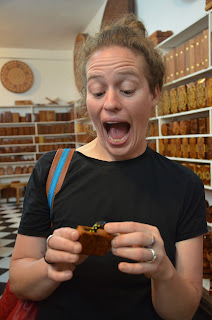It was hard to tear us away from Richard Branson’s
fancy-pants hotel this morning, but somehow we managed to clamber into the car
on time to head to Essaouira.
Along the way, we passed through the so-called Argan
Forest, a swath of land that is home to about 20 million argan trees that
supply the argan oil trade. Apparently, Morocco shares the argan tree with
Mexico (similar to how they share the agave plant) because of similar climates
and the way the countries used to fit together as part of Pangea. The argan
fruits are harvested once a year during the summer and the oil is sold, well,
everywhere all year round. Some tips from our fountain of knowledge, Ahmed, on
how to make sure your argan oil is the real stuff: it shouldn’t remain greasy
after it is applied, and it should freeze like butter if you put it in your
freezer.
As we drove through the forest, we saw the goats climbing
the trees to eat the argan fruit (perhaps with some encouragement from their
herders, who charge for photographs - don't worry, we haggled).
We then continued on to a feminine cooperative that makes
argan oil.
 |
| A sea of argan nut shells in front of the argan oil cooperative |
Creating these cooperatives was part of a sweeping government plan
to make living in rural areas more desirable so that people didn’t move to the
cities and create slums. It felt appropriate to visit on a day that celebrates
women around the world. One of the women walked us through how the fruits are
dried and then peeled, cracked (to get at the small argan nut inside of the
larger husk), and either roasted to produce oil for eating or cold pressed to
produce oil for cosmetics.
 |
| Step 1: de-fruit the husk |
 |
| Step 2: hammer the little argan nuts out of their acorn-like husk |
 |
| Step 3: grind it all up! |
The nuts are ground up in a traditional way between
two stones and mineral water is added to separate the oil from the paste. We
got to sample the roasted nut oil, argan honey, and a substance called amlou
that is a combination of ground roasted almonds, honey, and argan oil.
We continued on to Essaouira, a beach town that was also
known as Mogador (from the Berber word for “windy”).
Essaouira was the capital
of Morocco in the 18th century and, before that, was a major
production site for blue dye for the Romans (resulting in the so-called Purple
Islands off shore). It has had multiple incarnations since, including as a
hippie hangout in the 1960s and 1970s that spawned the gnawa music style that
is still celebrated annually at a festival in June. Throughout the centuries,
Essaouira has remained a bustling port and a relaxing beach town, now enjoyed
by both locals, traveling Moroccans, and international tourists alike.
The major crafts practiced in Essaouira are silver work
and wood carving, and of course we wanted to see both. We started at the Centre de la Bijouterie Artisanale Maalem Ali, a
silver workshop and store. We learned about the three styles of silver work:
filigree, enamel (the traditional Berber style), and engraving.
 |
| Bracelets with silver filigree |
Apprentices in
this craft spend three years learning the three styles. We saw six or seven
students practicing in the workshop, many of whom appeared to be blind. They
were thrilled when they discovered my sister could communicate a little bit in
sign language, though there was only moderate overlap between American Sign
Language and the local dialect.
We continued our walk, meandering down alleyways where
sea mists had worn the paint off of walls and curled the edges of posters and
pictures.
Big walls lined the city, interrupted by slits for archers or
cannons. A few more turns and we arrived at Centre Artisanal d'Essaouira, a workshop for wood craftsmen.
The salesman showed us the different colors of the different woods (lemon is
light, acacia is dark) and the difference between wood that came from the trunk
versus the root (more burled).
He also showed us the difference between inlay
and overlay and how the different pieces are sized and sealed in place. We also
got to play with the Moroccan “magic boxes”, which have several hidden pieces
that slide out to reveal first a key and then, with another few deft moves, a
keyhole.
The salesman initially said if we opened it successfully we could have
it for free, but soon regretted that promise when he saw what good puzzle-solvers
we were and started setting time limits to make sure we couldn’t win. The
workshop and adjoining store had a wealth of incredible pieces, reminding me
yet again how much I love woodwork.
 |
| A piece in progress from the workshop |
 |
| This little box had a surprise inside when you opened it |
The rest of the evening was spent walking back through
our hotel through the narrow labyrinth of the medina that we have come to know
and love in old Moroccan cities. We ended with our farewell dinner at a
restaurant that, strangely, forbids guides from dining with their clients. Good
thing we’re good at entertaining ourselves! We were sad, though, not to have
Ahmed’s company.
Spotted:
Additional photos from our day:
 |
| And the World's Most Photogenic Father Award goes to... |
 |
| Necklaces, including traditional Berber jewelry (center) at the silver shop |
 |
| Traditional blue wooden boats used by Essaouira fishermen |
 |
| Casually walking with a squid in each hand |
 |
| Essaouira street art |
 |
| A beautiful Moroccan metal lamp |
 |
| Our Bahia on her throne |













No comments:
Post a Comment